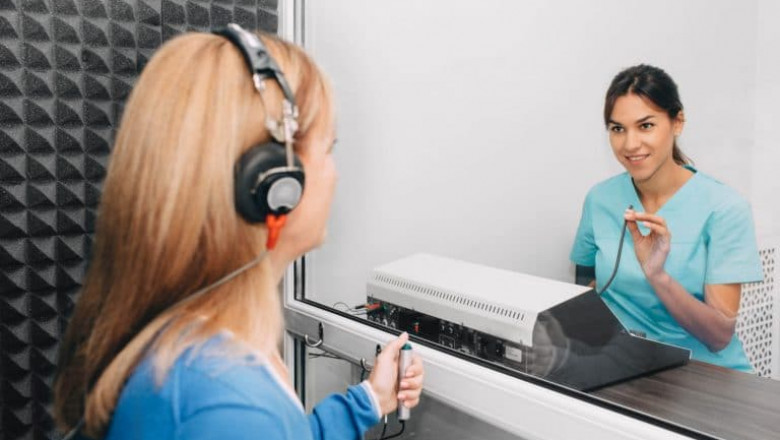views
Noise-induced hearing loss (NIHL) is one of the most prevalent yet preventable occupational health issues globally. As industries evolve with advanced machinery and operational demands, workplace noise levels can often exceed safe thresholds. Audiometric testing, a key component of hearing conservation programs, plays a vital role in monitoring and protecting employees’ auditory health. Ensuring regular hearing checks is not only a compliance measure but a strategic investment in workforce well-being and long-term productivity.
This article explores the importance of audiometric testing in the workplace, its legal and health implications, and how it benefits both employers and employees.
What is Audiometric Testing?
Audiometric testing is a hearing assessment used to measure an individual's ability to hear sounds at different frequencies and volumes. Conducted using an audiometer in a soundproof environment, the test helps identify early signs of hearing loss, particularly those caused by prolonged exposure to loud environments.
Workplace audiometric testing is typically part of a broader Hearing Conservation Program (HCP). These programs are required in many industries where noise exposure exceeds safe levels, commonly defined as 85 decibels (dB) over an 8-hour time-weighted average.
Why is Audiometric Testing Important?
1. Early Detection of Hearing Loss
Hearing loss often occurs gradually, making it difficult for individuals to notice. Regular audiometric tests can detect even minor changes in hearing thresholds before they develop into permanent impairment. Early intervention can help prevent further damage, improve quality of life, and maintain job performance.
2. Legal Compliance and Safety Standards
In Australia and many other countries, employers are legally required to monitor noise levels and provide audiometric testing for workers exposed to high noise environments. Failure to comply with regulations such as those under Safe Work Australia can result in penalties, legal action, and reputational damage.
For example, Work Health and Safety (WHS) Regulations 2011 in Australia mandate audiometric testing within three months of a worker commencing work in a noisy environment and then every two years thereafter.
3. Protection Against Workers' Compensation Claims
Employees who suffer from occupational hearing loss may file compensation claims. Implementing audiometric testing helps demonstrate that the employer has taken appropriate steps to mitigate risks, potentially reducing liability and insurance costs.
4. Improved Workplace Safety
Hearing loss can compromise safety by limiting a worker’s ability to hear alarms, machinery warnings, or verbal communication. This can increase the risk of accidents and injuries, particularly in manufacturing, construction, and mining sectors. Audiometric testing ensures that workers maintain adequate hearing capacity to perform their roles safely.
5. Supports Health and Well-being
Maintaining good hearing health directly impacts mental and emotional well-being. Untreated hearing loss has been linked to social isolation, depression, and cognitive decline. Regular testing shows employees that their health is a priority, enhancing morale and job satisfaction.
Industries That Benefit Most from Audiometric Testing
While any workplace with elevated noise levels should consider audiometric testing, it is especially critical in:
- Construction
- Manufacturing
- Mining
- Aviation
- Transportation
- Oil and Gas
- Forestry and Agriculture
These industries often use heavy machinery, power tools, or operate in environments where noise cannot be easily controlled, making audiometric testing essential for risk management.
Components of an Effective Hearing Conservation Program
A workplace hearing conservation program typically includes the following elements:
- Noise Assessment – Measuring and identifying noise levels using sound level meters or dosimeters.
- Engineering and Administrative Controls – Implementing noise-reducing technologies or rotating shifts to limit exposure.
- Personal Protective Equipment (PPE) – Providing earplugs or earmuffs for high-noise tasks.
- Audiometric Testing – Baseline and regular follow-up tests to monitor hearing over time.
- Training and Education – Informing workers about hearing risks, proper PPE use, and safe practices.
- Record Keeping – Maintaining detailed records of tests, noise levels, and employee training.
Mobile Audiometric Testing: Convenience and Efficiency
Many businesses today opt for mobile audiometric testing services. These are mobile units that visit job sites or facilities, providing on-the-spot testing for employees without disrupting operations. Mobile testing minimizes downtime and ensures consistent, compliant monitoring.
Overcoming Barriers to Implementation
Despite its importance, audiometric testing is sometimes overlooked due to perceived costs, logistical challenges, or a lack of awareness. However, the long-term savings—through injury prevention, reduced claims, and improved productivity—far outweigh the initial investment.
Employers should also work to eliminate stigmas around hearing loss. Encouraging a culture of safety and health awareness helps employees engage in hearing protection programs more effectively.
The Role of Employers and Employees
Employers are responsible for:
- Identifying and assessing noise risks.
- Providing appropriate testing and PPE.
- Ensuring all procedures comply with regulations.
- Keeping accurate records and acting on test results.
Employees play a key role by:
- Participating in scheduled hearing tests.
- Wearing PPE correctly and consistently.
- Reporting hearing issues or concerns promptly.
Conclusion
Audiometric testing is more than just a regulatory requirement—it’s a proactive approach to safeguarding one of our most essential senses. For employers, it ensures a safer, healthier, and more compliant workplace. For employees, it offers peace of mind and protection from the silent threat of hearing loss.
By integrating audiometric testing into routine health and safety practices, businesses can foster a culture of care and responsibility that benefits everyone in the organization.
Need Audiometric Testing for Your Workplace?
Partnering with a reliable occupational health provider ensures accurate testing, expert analysis, and full compliance with WHS regulations. Don’t wait until hearing loss becomes a problem—act today to protect your team’s health and your company’s future.






















Comments
0 comment